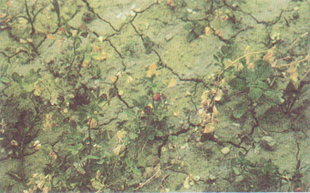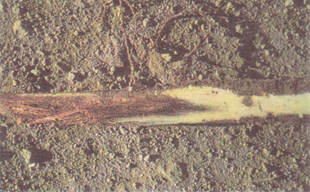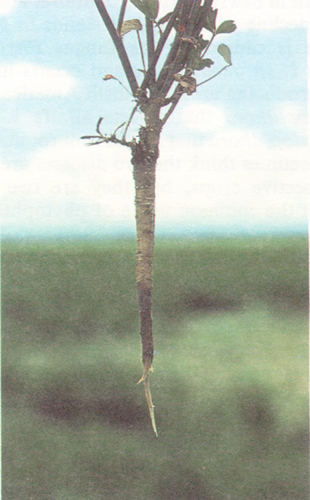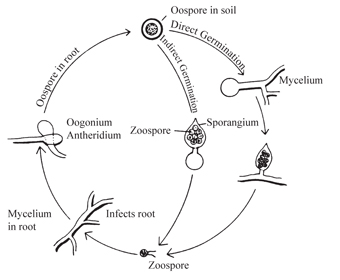G2078
Phytophthora Root Rot of Alfalfa
Phytophthora root rot is a major cause of seedling death in newly established alfalfa and causes a progressive decline of established stands in Nebraska. This disease is caused by the fungus Phytophthora megasperma f. sp. medicaginis and occurs in most of the alfalfa producing areas in North America.
Stephen N. Wegulo, Extension Plant Pathologist
Bruce E. Anderson, Extension Forage Specialist
- Disease Cycle and Occurrence
- Symptoms
- New Stands
- Established Stands
- Management of Phytophthora Root Rot
- Acknowledgment
Phytophthora root rot is most damaging on susceptible cultivars and where the soil remains wet due to high clay content (heavy, fine-textured soils), poor drainage, over-irrigation, or a combination of these. Phytophthora causes damping-off of seedlings, root rot, and rot of lower stems. It also weakens mature plants, making them more susceptible to injury during severe winters, and could eventually result in plant death.
|
Disease Cycle and Occurrence
Phytophthora megasperma f. sp. medicaginis survives in the soil as resting spores called oospores. Oospores are formed in infected roots and are eventually released into the soil following breakdown of the rotted roots. Optimum conditions for germination of oospores, infection, and disease development include temperatures of 65° to 75°F and nearly saturated soils. Under these conditions, the oospores germinate to produce sporangia, which release the infective motile zoospore stage.
The life cycle of P. megasperma f. sp. medicaginis is shown in Figure 1. The fungus is spread within and between fields by irrigation water carrying zoospores. It can survive and spread further in waste water from infested fields that is rechanneled back to the irrigation canal for use elsewhere. Oospores also can spread in soil attached to machinery or hooves of animals.
Phytophthora root rot is most severe in fields with poor internal drainage or in fields where soils become saturated by excessive irrigation or rainfall. Flood-irrigated stands that stay wet for up to 10 days are more likely to develop Phytophthora root rot than sprinkler-irrigated stands. However, severe root rot damage can occur in sprinkler-irrigated stands that are continuously irrigated, even in sandy soils.
Damage by Phytophthora may occur rapidly in spring in young stands when plants may die shortly after infection; or it may be delayed until summer in older stands when injured roots cannot adequately replenish moisture lost due to high temperatures and wind. Many older plants that have severe root rot die during the winter months. This results in severe stand thinning by spring.
Symptoms
In any field, Phytophthora root rot is most likely to occur in areas where water collects. Symptoms often are severest in poorly drained areas in the field, but in some fields with a high clay content the disease may occur throughout the field. Normally, plant death occurs in an irregular pattern in the field. Affected taproots are often pinched or damped-off immediately below the crown region, resulting in a “pencil-point” look.
New Stands
Newly seeded stands often suffer the greatest damage from Phytophthora root rot. Seedling failures appear to be more common in direct-seeded fields. Infected seedlings turn reddish-yellow, wilt, and die rapidly (Figure 2).
It is not uncommon for complete stand loss to occur in low areas of a field in just a few days. Stand failures often reoccur if these fields or infested areas are reseeded immediately, even if resistant cultivars are used for the second planting. Replanting a field in which the alfalfa stand was lost to Phytophthora root rot is costly and lowers the net economic return from that field due to higher establishment costs and delayed production.
Since infected seedlings die rapidly, it is difficult, if not impossible, to distinguish death caused by Phytophthora from that caused by other root rotting fungi such as Pythium. Plants that have a reddish to yellow cast are usually infected by Phytophthora. The taproot of Phytophthora-infected plants will be rotted and collapsed at a given depth below the soil surface. Only the smaller feeder roots of Pythium-infected plants rot. Postemergence damping-off typically occurs when plants are in the cotyledon stage of growth.
 |
 |
|
| Figure 2. Damping-off of seedlings caused by Phytophthora root rot. | Figure 3. Rot of the central cylinder of a taproot caused by Phytophthora root rot. |
Established Stands
On most plants affected by Phytophthora root rot, the taproot has a reddish-brown rot of the cortex. Rot of mature taproots typically starts 4 or 6 inches below the soil surface and causes a yellow to brownish-red discoloration of the outer cortical tissue, which eventually moves into the central cylinder (Figure 3). Rotted taproot tissue remains firm. Mature infected plants wilt and the lower leaves become yellow to reddish brown.
Under dry soil conditions, Phytophthora lesions become brownish to black in color, resembling the feeding injury caused by root curculio insects. When severe, the lower taproot is completely rotted off (Figure 4). Affected plants are severely stunted and yield less than one half the yield of healthy plants. Branching of the taproot often occurs above the point where the taproot is rotted off (Figure 5). Plants with rotted taproots are more easily removed from the soil.
 |
 |
|
| Figure 4. Rotted-off taproot due to infection by Phytophthora. | Figure 5. Branching of taproot caused by Phytophthora root rot. |
One of the best indicators of possible Phytophthora root rot is a thin, weedy stand with some plants that have irregular growth and stunting. If some of the stunted plants have the taproot rotted off, it is Phytophthora root rot. Regrowth of diseased plants is often slow after each cutting.
If you suspect Phytophthora root rot but lack confidence in your field diagnosis, collect several diseased (not dead) plants, including roots and soil, wrap them in a paper towel, place in a plastic bag with pencil-size holes for ventilation, and take them to your local extension office, or mail them to the Plant and Pest Diagnostic Clinic, Rm. 448, Plant Sciences Hall, University of Nebraska–Lincoln, 68583-0722.
Management of Phytophthora Root Rot
Site selection: Select fields with good surface and internal drainage and without a history of Phytophthora root rot.
Resistant cultivars: Use cultivars that are resistant or highly resistant.
Water and soil management: Improve soil drainage, level fields to prevent ponding, and irrigate to meet the needs of the crop and growing conditions. Do not allow irrigation water to stand on fields longer than two days.
Stand establishment: Treat good quality seed with a fungicide containing metalaxyl or mefenoxam and plant into a firm, mellow seedbed.
Crop rotation: Rotate fields with a history of Phytophthora root rot out of alfalfa for at least two years.
Fertilization: Fertilize newly seeded and established stands to promote vigorous growth and good root development.
Acknowledgment
John E. Watkins and Fred A. Gray were co-authors of the previous version of this NebGuide.
This publication has been peer reviewed.
Visit the University of Nebraska–Lincoln Extension Publications Web site for more publications.
Index: Plant Diseases
Field Crops
Issued May 2011
